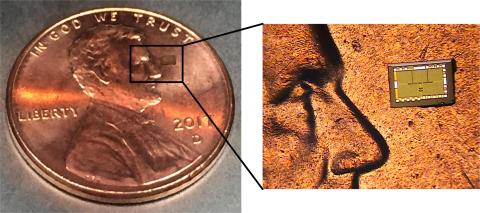Taiyun Chi, a recent ECE Ph.D. graduate, has been named as the recipient of the 2017 IEEE Custom Integrated Circuits Conference (CICC) Best Paper Award.
Taiyun Chi has been named as the recipient of the 2017 IEEE Custom Integrated Circuits Conference (CICC) Best Paper Award. Chi was presented with the award at the 2018 IEEE CICC, held April 8-11 in San Diego, California.
A December 2017 Ph.D. graduate of the Georgia Tech School of Electrical and Computer Engineering (ECE), Chi is now the RFIC design director at Speedlink Technology in Cupertino, California. While at Tech, he was a member of the Georgia Tech Electronics and Micro-System (GEMS) Lab, which is led by ECE Assistant Professor Hua Wang.
The title of the award-winning paper is “A Bidirectional Lens-Free Digital-Bits-In/-Out 0.57mm2 Terahertz Pico-Radio in CMOS with 49.3mW Peak Power Consumption Supporting 50cm Internet-of-Things Communication.” His coauthors on the paper are Wang, who also holds the Demetrius T. Paris Junior Professorship, and Min-Yu Huang, an ECE Ph.D. student in the GEMS Lab, and Fa Foster Dai and Hechen Wang, both of the Department of ECE at Auburn University.
Internet-of-Things (IoT) hold the promise for revolutionizing almost every industry sector in our society. These IoT devices will establish massively parallel and distributed wireless networks that connect almost any physical device, which realizes the ultimate integration of the physical world with computer-based cyber systems and enables automation in numerous areas, such as smart home, connected health, media/entertainment, manufacturing, and agriculture.
In this paper, Chi and his colleagues have demonstrated a bidirectional low-power radio platform for field-deployable wireless sensor network and Internet-of-Things (IoT) applications. Compared with existing low-power radios that mostly operate at MHz-GHz frequencies, their proposed pico-radio utilizes THz carrier (320GHz) and nonlinear transmitter/receiver architecture, which leads to a radical reduction of antenna/electronics sizes and power consumption and results in sub-millimeter-scale form factor ("pico-size") and radio ultra-miniaturization.
The THz radio also enables power-performance scalable operation, where the radio power consumption can be dynamically optimized to optimally support the actual link distance and required data rate, achieving an average micro-watt-level power consumption by duty cycle operations. The THz pico-sized radio is demonstrated using commercially available low-cost CMOS 45nm SOI process. This work is the first exploratory study and first working hardware demonstration of IoT devices using THz frequency. It realized an up-to 0.5m link distance between two CMOS THz pico-radios with a 4.4Mb/s data rate, achieving a world-record communication distance among reported THz radios and a very competitive link performance even among all of the reported MHz-GHz IoT radios. Together with energy harvesting/storage and in-situ feature-extraction computation, this CMOS THz pico-sized radio opens the door for massively field-deployable IoT devices and ultra-miniaturized wireless sensor nodes that are practically "invisible,” which will ultimately support future trillion-scaled IoT networks.
Additional Images
